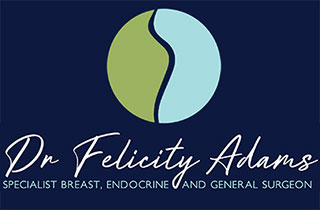Mastectomy
Mastectomy is surgery to remove the whole breast from the chest wall. Sometimes mastectomy is the only safe way to treat a patient’s cancer, other times patients may elect to have their breast removed when conserving the breast is also an option.
Dr Adams may recommend a mastectomy if:
- Your tumour is very large
- There are multiple areas of cancer spread through the breast
- Your breasts are very small relative to the size of your tumour
- You are unable to have radiotherapy

Some patients choose a mastectomy over lumpectomy as it gives them better peace of mind. Others do not want to commit the time and sometimes travel the distance to attend radiation (which is required for breast conserving surgery) so chose mastectomy. The choice is an individual one.
There are many different types of mastectomy. A routine or standard mastectomy is termed a “simple mastectomy”. This involves removal of all of the breast, the nipple and the majority of this skin leaving the underlying muscles intact. Patients are left with a flat chest with a scar. In other cases, less skin is removed (a skin sparing mastectomy) or the nipple and areola are preserved along with all the skin from the breast (a nipple sparing mastectomy). Mastectomy is usually combined with lymph node surgery which in simple mastectomy is done through the same incision.
A simple mastectomy is performed under general anaesthetic and usually takes between one to two hours. Patients usually stay in hospital for two days. Drains are placed and patients are shown how to care for them as most often they are discharged with them still in. Whilst in hospital you will be reviewed by a physiotherapist and the Breast Care Nurse. There may be pain but usually this is not severe, and pain relief will be given to you prior to discharge from hospital.
The tissue excised is sent away to a pathologist who looks at the tissue under a microscope and provides a report. This histology report gives important information about the type of tumour, the grade, the hormone receptors and the presence of any cancerous lymph nodes. This process takes several working days so is not available during the operation.
Dr Adams will meet with you approximately one week after surgery. At this appointment a general review is undertaken and your histology or microscope report is discussed. The report helps to guide further treatment decisions.
Other treatments which may be required include:
Some women choose to have breast reconstruction after mastectomy, others wear a prosthesis in their bra or are happy to go flat chested. Reconstruction if desired can be done at the time of the initial cancer surgery or at a later time; your options with respect to this depend on your individual situation which Dr Adams is happy to discuss with you in your consultation.

